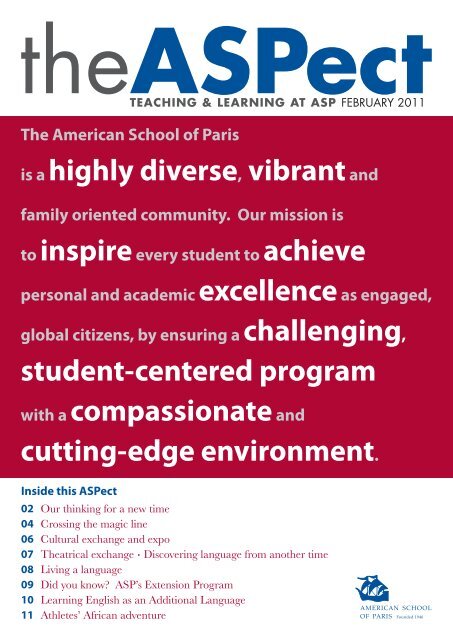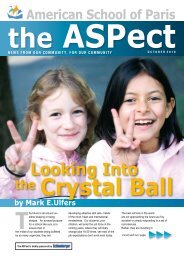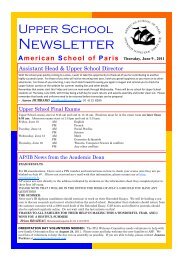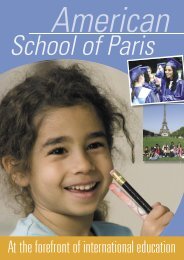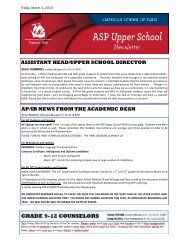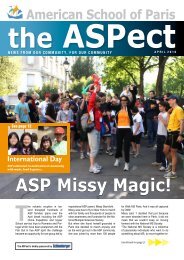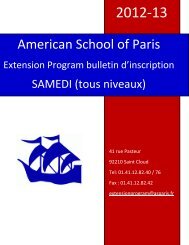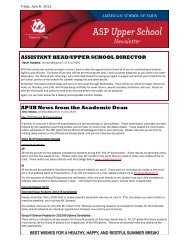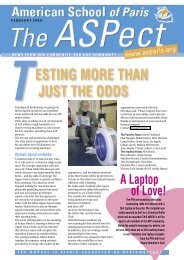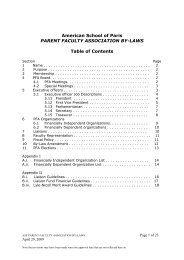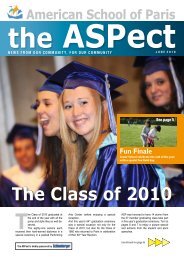ASPect 6fev 15h30.indd - American School of Paris
ASPect 6fev 15h30.indd - American School of Paris
ASPect 6fev 15h30.indd - American School of Paris
Create successful ePaper yourself
Turn your PDF publications into a flip-book with our unique Google optimized e-Paper software.
the<strong>ASPect</strong>TEACHING & LEARNING AT ASP FEBRUARY 2011The <strong>American</strong> <strong>School</strong> <strong>of</strong> <strong>Paris</strong>is a highly diverse, vibrant andfamily oriented community. Our mission isto inspire every student to achievepersonal and academic excellence as engaged,global citizens, by ensuring a challenging,student-centered programwith a compassionate andcutting-edge environment.Inside this <strong>ASPect</strong>02 Our thinking for a new time04 Crossing the magic line06 Cultural exchange and expo07 Theatrical exchange . Discovering language from another time08 Living a language09 Did you know? ASP’s Extension Program10 Learning English as an Additional Language11 Athletes’ African adventure
SCHOOL NEWS 03The <strong>American</strong> <strong>School</strong> <strong>of</strong> <strong>Paris</strong>is a highly diverse, vibrant andfamily oriented community. Our mission isto inspire every student to achievepersonal and academic excellence as engaged,global citizens, by ensuring a challenging,student-centered programwith a compassionate andcutting-edge environment.OBJECTIVES• Each student will set and achieve challenging educational goalsrelated to academics, aspirations and personal interests.• All students will meet or exceed appropriate performance standardsand pr<strong>of</strong>iciency levels in English and French, and we will increase thepercentage <strong>of</strong> students learning additional languages.• Every student will understand and consistently demonstratethe character attributes to be a contributing global citizen andresponsible leader.• All students will demonstrate increasing pr<strong>of</strong>iciency in suchinterdisciplinary skills as critical thinking, problem solving,communication, collaboration, digital literacy and creativity.STRATEGIES• We will develop, implement and communicate a rigorous, relevant,assessed K-12 curriculum, specifically designed to achieve academicexcellence and aligned to our mission and objectives.• We will fully exploit the benefits <strong>of</strong> technology to best achieve ourmission and objectives.• We will develop and implement long-term plans to secure ourfinances, facilities and campus necessary to fulfill our mission.• We will develop, implement and assess an expanded French andadditional language-learning programs.• We will develop and support faculty, administration and staff tocontinuously improve pr<strong>of</strong>essional performance and maximizestudent learning.• We will design a system to support students in setting andachieving educational goals related to academics, aspirations, andpersonal interests.• We will identify, model, reinforce and recognize the characterattributes, which enable every student to be a contributing globalcitizen and responsible leader.We are interested in your thoughts about the DRAFT strategic plan framework above.Join the forum on http://poodle.asparis.fr/poodle or send us an email: board@asparis.fr or mulfers@asparis.frthe<strong>ASPect</strong> February 2011
04 FOCUS ON LANGUAGE LEARNINGCrossing the magic lineLanguage learning in Lower <strong>School</strong>Learning French in Lower <strong>School</strong> is to enter a world where stories and fairy tales reign, aworld where a form <strong>of</strong> sign language accompanies every phrase at the beginning level, and aworld where the children themselves insist that you speak French.“Et maintenant tu traverses la ligne magique…”From the first day in Kindergarten at the age <strong>of</strong> 4-years-old, our Lower<strong>School</strong> students know that when they cross the magic line into theirFrench classroom, no English is allowed, but also that languagebecomes an adventure.The French team in the Lower <strong>School</strong> is proud <strong>of</strong> their program, andrightly so, as what they have built, and are still building, is a uniqueprogram that is garnering interest from teaching colleagues fromother schools.Lower <strong>School</strong> French Team Coordinator Jean-Pierre Heussaffexplained: “Five years ago I saw a video clip in which a first graderwho had never learned French before was reading French in his firstyear <strong>of</strong> learning and I couldn’t believe it!”And so ASP discovered a pioneering program – the AcceleratedIntegrated Method – devised by Canadian educator Wendy Maxwell.AIM uses hand gestures to teach high frequency words which allowchildren to learn vocabulary and grammar with astonishing speed forsome, and to eventually correct themselves through the sophisticatedform <strong>of</strong> hand signing.LS French Teacher Nadine Bertoglio said: “Once the children get to acertain level, we can correct their grammar without interrupting themwhile they are talking. For example, by just moving our finger like this(bends her index finger down) we as the teacher can correct the use <strong>of</strong>a verb in the infinitive and the child will correct themselves asthey talk.”
FOCUS ON LANGUAGE LEARNING 05In the first year <strong>of</strong> learning (more than 100 hours for each student),the students will learn at least 350 high frequency words andthe accompanying hand gestures, which will increase to 750 intheir second year <strong>of</strong> learning – a level which corresponds to thefundamental French vocabulary.And <strong>of</strong> course the teachers were the first to have to learn!Teacher Veronique Baudin said: “It was a very big undertaking for usat the start – and we are still always learning. We practice every day.We have a DVD data base where we can discover new words and wealso check constantly with each other that our signing is the same sothat there is always consistency. But it is also true that it has becomeso integrated into our teaching that we do it naturally.”In the beginning, all words and phrases are spoken and signed by thestudents and the teachers. As the students become more comfortablewith those high frequency words and phrases the signing is mainlyused to introduce new ideas for the next level <strong>of</strong> acquisition – theintroduction <strong>of</strong> new vocabulary or for grammatical correction.Jean-Pierre said: “There are more than 2,500 words that can besigned using AIM, but we only took from the AIM method whatcould improve our teaching and the children’s learning, not theentire program.”And as Jean-Pierre is quick to point out, the ‘gestures’ adopted fromAIM are only one element to the Lower <strong>School</strong> French program.He said: “The real heart <strong>of</strong> the program is the stories. The ‘gestures’give the children access to the language, but it is the storytellingclasses and field trips and the learning in French supports thoseunits, tailored to the pr<strong>of</strong>iciency. For example, with Monet in4 th Grade, our beginners would focus on vocabulary with colors,but our francophone students would explore the art movement<strong>of</strong> Impressionism.”Combining language acquisition with cross-curricular activities is justone <strong>of</strong> the areas that the team is constantly reviewing and updating.And this month the six-strong team spent two full days to startrecording their curriculum in order that they can more formally auditwhat they are doing in their quest for continual improvement.Jean-Pierre said: “We are always looking at whatworks, what doesn’t work, what can we try, what canwe learn? And our next step is to audit what we haveand start to develop a sensitive, continuous, formalizedevaluation and assessment in order that we cancontinue to maximize learning for our students.”which brings the learning alive and captures theirimagination. It is the stories and theatrical piecesthat make the French program so successful.”Every unit at every language pr<strong>of</strong>iciency levelin every grade has a story at the center <strong>of</strong> thelearning, many <strong>of</strong> them refined and honed over theyears in a never ending process <strong>of</strong> evaluation andimprovement for the program.In addition, from the beginners through t<strong>of</strong>rancophone classes, the students are alsointroduced to the richness <strong>of</strong> our host countryculture in French – from art and architecturethrough to traditions, customs and cuisine.Nadine gave an example: “In 3 rd Grade the studentsstudy Van Gogh, in 4 th Grade it is Monetand in 5 th Grade Picasso. These are units whichcross disciplines with the homeroom, the artthe<strong>ASPect</strong> February 2011
06 FOCUS ON LANGUAGE LEARNINGCultural exchange and expo!Sharing cultural traditions was the stepping stone for both the French exchangeprogram and a special international student exhibition in Middle <strong>School</strong> this year.For several years, students from all levels in grades 6 through 8 havebeen involved with a student exchange program with a neighboringCollege Yves Du Manoir - in Vaucresson. And this year it was the turnfor the Grade 6 Beginners and the Grade 7 Intermediate 2 classes.Grade 7 Teacher Lara Bailly explained: “The idea this year was to swapand celebrate cultural traditions. So our students went to celebrateThanksgiving at the college which the French students had preparedfor us, and this month we invited them to ASP and we prepared aGalette des Rois. The cultural traditions were the highlights <strong>of</strong> thevisits but the students also participated in small groups with theircounterparts in science, English, social studies, Math, French andEAL lessons.“We also allowed the students plenty <strong>of</strong> time for more informalinteraction with a tour <strong>of</strong> the campus in French and English andfinishing the day with basketball and handball games. It is importantthat they all get to practice both their French and English with nativespeakers and discover the differences and similarities in their lives,both at school and out <strong>of</strong> it. There are moments when the lessinvolved we are as teachers the more the students gain fromthe experience.”For the beginners in Grade 6, the exchange was necessarilymore structured. Teacher Valerie Jackson explained:“We focused on the school day and the students madepresentations using posters that they had previouslyprepared in class detailing subjects, timetables, classroomsand teachers. They learned vocabulary and everyone couldformulate a descriptive phrase or ask a question aboutschool life. They were asked to make observations about andcomparisons between the French and <strong>American</strong> schooldays.In November last year the students came to ASP and thismonth our students visited them, also participating in regularclasses but in a more observational way.”A difference that many students noticed was the inventiveand involved way that students are encouraged to exploretheir subjects at ASP, exemplified by an exhibition hosted bythe Grade 6 Advanced French Class for what could have beena dry grammar unit learning the ‘passé compose’, but which becamea rich celebration <strong>of</strong> ASP’s international cultures and fascinatingexploration <strong>of</strong> immigration and what it means to be a citizen.Teacher Valerie Jackson said: “I noticed that in a class <strong>of</strong> 16 studentswe had 12 different nationalities, and so all the children preparedexhibits about their home countries but using the grammar theyhad been learning for descriptions, comparisons and talking aboutthe past.”Sixth Grade Student Freddy Ludtke explains… in French! “Le 18novembre nous avons fait une exposition de nos pays. Les 7 thFrancophones, et les 8 th Beginners sont tous venus nous voir. C’étaitcomme un musée! Il y avait des expositions sur les États-Unis,l’Espagne, la Corée, le Japon, le Mexique, la Belgique, l’Argentine,et le Canada. Nous avons fait des présentations Powerpoint et desposters pour parler de nos pays. Aussi, on a ajouté le passé composé,l’imparfait, les directions et l’utilisation de qui, que et où. C’est tout cequ’on a travaillé pendant le trimestre. Nous avions un peu peur mais,après quelques minutesc’était très amusant. ”
FOCUS ON LANGUAGE LEARNING 07Theatrical exchangeIn Upper <strong>School</strong> a French exchangewith a local French Lycée has inspiredASP students to launch a miniFranco-English drama festival.Building on an idea that started last year, more than 35 intermediateFrench students are currently writing and rehearsing original theatricalpieces which they will perform to students from the Lycée in Marly LeRoi this Spring. In addition, students from the Lycée Louis De Broglieare creating their own original pieces in English which they will inreturn perform to our students when they come together. This monththe students from ASP visited the Lycée to set their plans in motion.Upper <strong>School</strong> French teacher Mima Fayad said: “This was a chancefor our students to visit a French High <strong>School</strong> and to start workingtogether in groups. It was a fun way to discover a little more abouteach other’s cultures and above all practice their languages (Frenchfor us and English for them) with native speakers.”The students exchanged objects – a piece <strong>of</strong> music, an item <strong>of</strong>clothing, a picture etc – and then each group is tasked to build a playusing these objects in a straightforward or creative way with thestudents writing their story, creating the play, assigning roles andrehearsing, all in French.Ms Fayad said: “This is quite a challenging project and it will beexciting to see the results with the different approaches that comefrom the students who range in age from Grade 9 through Grade 12.”Discovering Language from Another TimeBy Virginia LarnerUpper <strong>School</strong> English DepartmentAt the end <strong>of</strong> last year, thirty-two Upper <strong>School</strong> students and teachersattended a sold-out performance <strong>of</strong> Julius Caesar in English at theTheatre Gerard Philipe in Saint-Denis.The <strong>American</strong> Repertory Theater <strong>of</strong> Cambridge, MA set theplay’s dramatic action in the US <strong>of</strong> the 1960’s with its iconicimages, period dress and innovative rendering <strong>of</strong> the languagethrough various media: projected television screens, hauntingmusical pieces, pauses lengthening into gestured silences, andcontrolled articulation <strong>of</strong> lines.As many <strong>of</strong> our students feel that reading Shakespeare is already anadventure in translating a “foreign language”, actually watchinga live performance on stage renders this daunting task moreaccessible and even enjoyable when such language is not reducedto mere recitation.So, the ART set to words the fear <strong>of</strong> tyranny and revolt in an ancienttime, calling on contemporary technology with its panoply <strong>of</strong> visualarts to do so. This multi-layered approach to language seemed tobroaden student refl ection on the use and abuse <strong>of</strong> power duringthe dizzying eras <strong>of</strong> imperial Rome, the Sputnik challenge to UShegemony, and global unrest today.Reactions to this three-hour Shakespearean productionwere immediate. Senior Hayley Howard was delighted with“the inspiring acting, creative sets, and jazz music” while11 th grader Chris Carjuzza enjoyed the game <strong>of</strong> power Julius Caesarhimself engaged in with an admiring Roman crowd, was intriguedby the close relationship between Brutus and servant Lucius thatcentered on food and sleep, but deplored the trendy, hip stage sets.Twelfth graders Beatrice Verez and Danielle Iwata applauded theoriginal use <strong>of</strong> sign language and hand gestures that indicated intheir own way both closeness and distance.In addition, the main actors held a Q and A with the audience afterthe performance and ASP was active in this exchange as one <strong>of</strong> ourseniors started the session with a pertinent question about the creativerole <strong>of</strong> jazz and blues as a backdrop to the dramatic scenes.In answer, director Arthur Nauzyciel evoked his vision <strong>of</strong> seeingmusic as another form <strong>of</strong> language, indissociable from the poetic text.His answer led to an animated discussion about the cast’s use <strong>of</strong>silence and gesture as equally potent linguistic signs. One studentlater confi ded that learning Shakespeare is like learning a foreignlanguage you already knew as a child, but have forgotten. Whenyou see one <strong>of</strong> his plays on stage, he said, the beauty and force <strong>of</strong>its mysterious lines bring you back to the excitement and awe youfelt when you could express emotions <strong>of</strong> love, anger, and fear withnewly-found words and gestures.the<strong>ASPect</strong> February 2011
08 FOCUS ON LANGUAGE LEARNINGLearning in the fieldby Anna Bradley Webb and Chloe Dorgan(Grade 11)Upon arrival in Madrid, we took multiple metro lines to get to ourhostel, just in time to enjoy a traditional Spanish breakfast <strong>of</strong> tostadas(toasted bread with jam) and consume some much-needed caffeine.After settling in, we left the hotel and walked to the Palacio Real,where our tour guide, Javier, gave us a tour, providing Spanishexplanations <strong>of</strong> the various rooms and decorations <strong>of</strong> the home <strong>of</strong>many previous monarchs. We enjoyed the panoramic view <strong>of</strong> theterrace <strong>of</strong> the Palace, and after lunch, we walked to the Museo delPrado. Although at this point staying awake had become a struggle,we were engaged both by the art and by Javier’s explanations aboutBosh, Velazquez and Goya.After our tour <strong>of</strong> the museum, we had free time to explore the city,in which some students shopped at the Spanish department storeEl Corte Ingles, while others had far too much chocolate con churros,Living a languageEvery year Upper <strong>School</strong> Spanish program founderClaudine Delalande takes students from ASP’sadvanced Spanish classes to Spain. She said:“It is an invaluable way <strong>of</strong> reinforcing their learningand although short, the immersive aspect <strong>of</strong> beingsurrounded by Spanish is extremely importantin bringing language learning alive. The trips toMadrid or Barcelona are art orientated and beforeleaving, students learn about Spanish paintingand architecture in the context <strong>of</strong> some aspects<strong>of</strong> Spanish history. This year we studied somepaintings <strong>of</strong> the most famous Spanish artists likeEl Greco, Velazquez, Goya and Picasso.“Also, a part <strong>of</strong> this academic trip is to observe andparticipate in the Spanish way <strong>of</strong> life. We use publictransportation, walk through the city, go shoppingand the local guides we use speak only in Spanish.It reinforces their confidence in comprehension asmuch as giving them an opportunity to practice.”This year 18 students visited Madrid and Toledoduring the Thanksgiving break.“The Spanish course at ASP has been one <strong>of</strong> mybiggest sources <strong>of</strong> growth. I started in Spanish 1,clumsily stumbling over verb tenses and nowI am in Spanish 5, actively debating in class.”Chloe Dorgana traditional Spanish desert <strong>of</strong> deep-fried dough and thick hotchocolate, and lost their appetites for dinner. Dinner was a threecoursemeal at the Museo del Jamon (the Museum <strong>of</strong> Ham), includingthe traditional paella, with shrimp and sausage.The next day, we explored the beautiful Atocha station or thebotanical gardens before taking the train to Toledo, Spain’s formercapital. Our guide gave us a tour <strong>of</strong> this beautiful, medieval townwhere there were few tourists, and we saw the cathedral, synagogue,and other historical monuments. We also saw one <strong>of</strong> the mostfamous Greco’s painting “El entierro del Conde de Orgaz”.We learned about its intricate religious and cultural history. Thatevening, we ate at a traditional tapas restaurant, where we were<strong>of</strong>fered a variety <strong>of</strong> Spanish dishes.Saturday, we made the most <strong>of</strong> our last day in Madrid. We walked tothe Museo de la Reina S<strong>of</strong>ia, the modern art museum <strong>of</strong> Madrid. Wehad a tour centered around Picasso’s famous Guernica, his piece inprotest <strong>of</strong> the Spanish Civil War, and saw other pieces on this subject.We spent our last few hours before going to the airport havinglunch, and no one was ready to leave Madrid when we got backon the plane to <strong>Paris</strong>.
10 FOCUS ON LANGUAGE LEARNINGLearning English as an Additional LanguageWhen we think <strong>of</strong> language learning we automatically think <strong>of</strong> ourFrench and Spanish programs, but as an international school, everyyear we welcome many students who do not speak a word <strong>of</strong> English.Language learning at ASP for more than 50 students in Lower andMiddle <strong>School</strong> this year alone started with learning English.The EAL team (Sarita Cole, Carole Rowlands, Linda Franco, BarbaraTrudeau and Ana Wier) ensures that all those students can make thetransition and become fully integrated into mainstream academic lifewithin two years.Students are taught English for social and academic purposes. EALspecialists Sarita Cole and Carole Rowlands explain: “Academiclanguage – the language <strong>of</strong> a subject matter – is fundamentallydifferent from conversational language. Students can take up to threeyears to achieve the social language level <strong>of</strong> their peers and 5 to 7years to achieve academic language pr<strong>of</strong>iciency. As students progressthrough the grades they encounter far more low frequency words,complex syntax and abstract expressions that are <strong>of</strong>ten only heardin an academic context. EAL students must continually gain morelanguage pr<strong>of</strong>iciency each year than their native speaking peers.”The students in the Lower <strong>School</strong> EAL program are taught duringthe language arts periods in their schedules and so, importantly, donot miss any other subjects. In Middle <strong>School</strong>, EAL classes are duringEnglish and Social Studies. The team will <strong>of</strong>ten pre-teach upcomingsubjects to give the students a head start with vocabulary in orderthat they can participate with their classmates and not feel ‘lost’.In addition, teachers join the current students in their mainstreamclasses to accompany them in some subjects whilst still supportingexited students for a further two years.Enjoy this report by Barbara Trudeau illustrating the inter-disciplinarynature <strong>of</strong> the Lower <strong>School</strong> EAL program, where language meetsmath and art.THE STORY OF A CUBE ENCOUNTERBy Barbara Trudeau and Grade 5 EAL studentsThe Momentum project exhibiting in The Cube at the end <strong>of</strong> last year by Jonathan Saiz wasa perfect moment for a cross-curricular discovery by fifth graders in the EAL program.The students were studying volume in their math classes, and producing effective writingin their EAL classes. We followed the project through its various stages and watched, measured,interviewed, and conjectured. We were pleased to have the opportunity to experiencea learning project which appealed to our class’s multiple learning styles!“On a November day, our classtook a trip to the big cube. I wasexcited to visit the artist who builtthe cube.” Bennet“We estimated the height <strong>of</strong>the cube but we all got it wrongexcept me.” Zaccharie“We got so interested in thecube that we wanted to knowwhat were the length, widthand height.” Paloma“The cube was painted withwaves and could feel the wavesand could smell the paint. Thesky was gray; it was awesome.”Alex“In length it was 2.5 meters, inheight 2.5 meters, in width 2.5meters. We went up to see thecube from the top; it was open.”Mikkael“We saw a towering cube withblack paint.” Alex“Jonathan, the artist told us thathis goal was to make us feel thewaves and somehow we did!”Bennett“Also Ms Trudeau asked ifit was a cube or a rectangularprism. The artist said it wasa rectangular prism. The dayafter we came with our rulers tomeasure the volume and when wesaw the cube it was painted withwaves.” Victor
SPORTS NEWS 11ATHLETES’AFRICANADVENTUREThis year’s basketball season will be one to remember forASP’s athletes even before they arrive at the end <strong>of</strong> seasonISST tournament.The Boys and Girls Varsity Basketball teams have been invited tothe International <strong>School</strong> <strong>of</strong> Kenya during the February break fora tournament in which not only will they play students from theinternational school, but also several local teams.It will give them a chance to spend a week building on theirstrengths and focusing on their game just before the International<strong>School</strong>s Sports Tournaments, hosted at ASP for the Girls and atACS Cobham for the Boys (March 9-12).The Girls are enjoying a spectacular season with only one loss afterplaying weekend games against seven opposing teams; Brussels(St.John’s), The Hague (ASH and BSN), Amsterdam (ISA and Antwerp),ISH and ACS Cobham International <strong>School</strong>.And after a slow start, the Boys have picked up a winning streakover the last two weeks and have a 9/5 win/loss record.And the Kenya trip will not just be about game tactics on the court,but also provide the teams with valuable <strong>of</strong>f-court team buildingactivities such as rock climbing and kayaking in addition to thecultural experience <strong>of</strong> playing with local Kenyan teams.The 21 students and their three coaches (John Kim, Barbara Hoegenand Keith Holman) will spend three days in the Nairobi National Parkand Upper <strong>School</strong> teacher John Kim has been impressed with thestudents’ engagement: “They are really keen to maximize the intercultural aspect <strong>of</strong> the trip and are also researching ways in which theymight participate in some volunteer activities.”Athletic Director Han Hoegen said: “We trust that the Kenya trip willhave a positive effect on both teams through team building as wellas a new cultural learning experience with this great and excitingopportunity the International <strong>School</strong> <strong>of</strong> Kenya is giving us by invitingthe Varsity basketball teams.”the<strong>ASPect</strong> February 2011
Get ready forthe Bollywood GalaA Celebration to Benefit ASP!Come and experience the glamour and energy <strong>of</strong> Bollywood!Champagne reception, music & entertainment, dance, gourmet cuisine, plusunique auction items benefiting the school, will all be part <strong>of</strong> this exciting event. With the beautifulPré Catelan as our backdrop, plus the vibrant colors, sights, sounds, and exotic fragrances <strong>of</strong> India,we’re planning a spectacular evening which you won’t want to miss!You should have received an invite via e-mail, but if not, visit the GALA section <strong>of</strong> our websiteto buy tickets or to take advantage <strong>of</strong> sponsorship opportunities. All proceeds from theASP 2011 Bollywood GALA will benefit the 2010-2011 Excellence Fund.Reserve soon to avoid disappointment!Questions? Contact Michael McNeill: mmcneill@asparis.fr23


